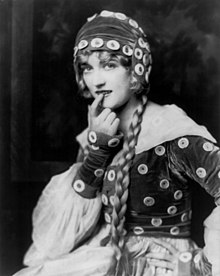Cosmopolitan Productions, also often referred to as Cosmopolitan Pictures, was an American film company based in New York City from 1918 to 1923 and Hollywood until 1938.
History[edit]

Newspaper tycoon William Randolph Hearst formed Cosmopolitan in conjunction with Adolph Zukor of Paramount after Hearst's bid for entry into the motion picture business was rebuffed by United Artists.[1] The advantage of Paramount having a production deal with Cosmopolitan was that they had the film rights to stories that had appeared in the wide variety of Hearst's magazines. These included Cosmopolitan magazine (from which Hearst took the film company's name), as well as Harpers Bazaar, and Good Housekeeping. Thus the stories arrived pre-sold to the public, who were familiar with them through reading them in Hearst's magazines.[2] Hearst's magazines would also advertise and promote his films.
Cosmopolitan's first successful film was Humoresque (1920), which also was the first film to receive the Photoplay Medal of Honor.[3]
For its studio complex, Hearst acquired Sulzer's[4] Harlem River Park and Casino[5][6] at 126th Street and Second Avenue[7] but a fire[8] on February 18, 1923, destroyed the complex[9] while shooting Little Old New York with Marion Davies, directed by Sidney Olcott. The sets had been designed by Joseph Urban.
Cosmopolitan heavily promoted the career of Hearst's lover, actress Marion Davies. She appeared in 29 silent and 17 talking films with the company.
Due to disagreements with Paramount in the distribution of the Cosmopolitan Pictures in block booking venues, Hearst left Paramount to have his films released by other studios. Starting in 1923, they were distributed or co-produced by Metro-Goldwyn-Mayer until 1934 when a disagreement with Louis B. Mayer over the film Marie Antoinette led Cosmopolitan to go to Warner Bros.[10]
Legacy[edit]

Robert G. Vignola was a director strongly associated with Cosmopolitan Productions. He directed several films there, including the extravagant When Knighthood Was in Flower (1922), which at a cost of $1.8 million, was then the most expensive picture ever made. Director King Vidor made three comedies with Cosmopolitan: Show People (1928), The Patsy (1928) and Not So Dumb (1930), each starring Davies. One film without Davies was The Mask of Fu Manchu (1932, MGM).
Other important directors worked briefly with Cosmopolitan, such as John Ford with Young Mr. Lincoln (released 1939), Michael Curtiz with Captain Blood (released 1936), and Howard Hawks with Ceiling Zero (also in 1936).
Notes[edit]
- ^ pp. 279-280 Nasaw, David The Chief: The Life of William Randolph Hearst 2001 Houghton Mifflin Harcourt
- ^ p. 280 Ibid
- ^ Koszarski, Richard (2008). Hollywood on the Hudson: Film and Television in New York from Griffith to Sarnoff. Rutgers University Press. p. 118. ISBN 978-0-8135-4293-5.
- ^ From Sulzer’s Harlem River Park to Krause’s Halfmoon Beach : History of Mascot on the 19th Century Louis Bopp-Charles Looff Carousel
- ^ p.102 Koszarski, Richard An Evening's Entertainment: The Age of the Silent Feature Picture, 1915-1928 University of California Press
- ^ "SULZER'S PARK FIRESWEPT.; Famous Amusement Resort on the Upper East Side Destroyed". November 22, 1907.
Sulzer's Harlem River Park, which covered the entire block bounded by First and Second Avenues and 126th and 127th Streets
- ^ 40°48′12″N 73°55′59″W / 40.8034333°N 73.9331095°W126th Street and Second Avenue
- ^ "$1,000,000 BLAZE RUINS FILM STUDIO; The Cosmopolitan Productions Plant, Covering a City Block, Burns in Early Morning". February 19, 1923.
Studios of the Cosmopolitan Productions, located in the block surrounded by 126th and 127th Streets and Second Avenue and East River, suffered a loss of $1,000,000 by fire early yesterday morning. The studio's electrical equipment and scenery, and almost the entire wardrobe, were destroyed.
- ^ p. 208 Pizzitola, Louis Hearst over Hollywood: Power, Passion, and Propaganda in the Movies Columbia University Press
- ^ p.189 Procter, Ben H. William Randolph Hearst: Final Edition, 1911-1951 2007 Oxford University Press